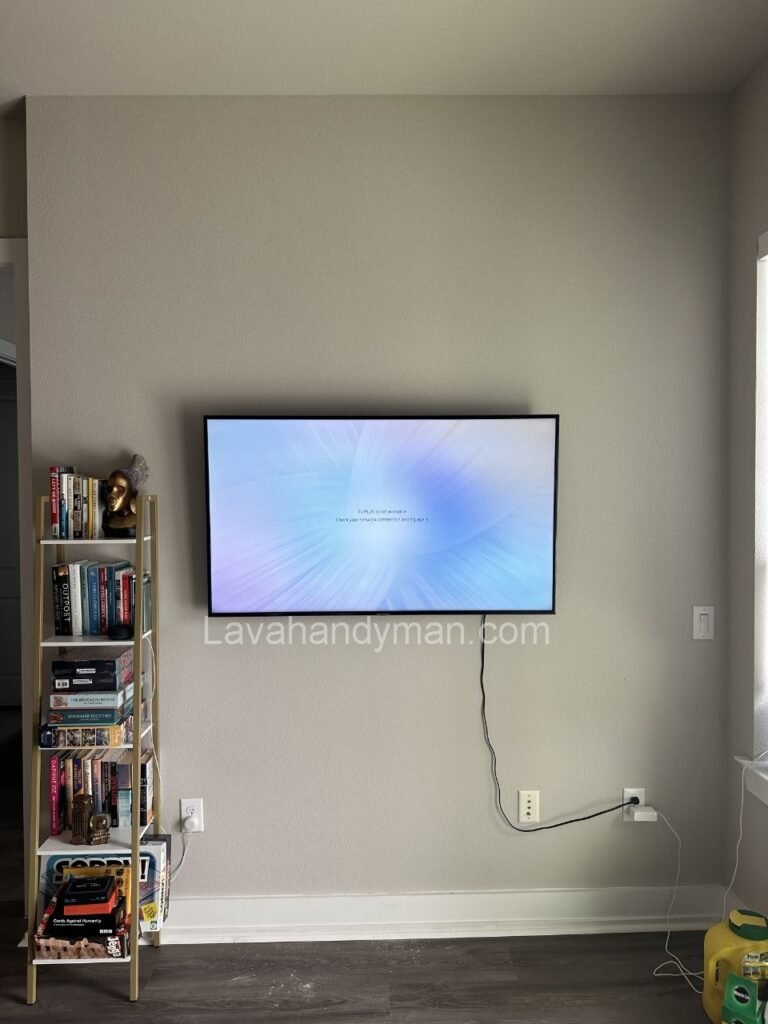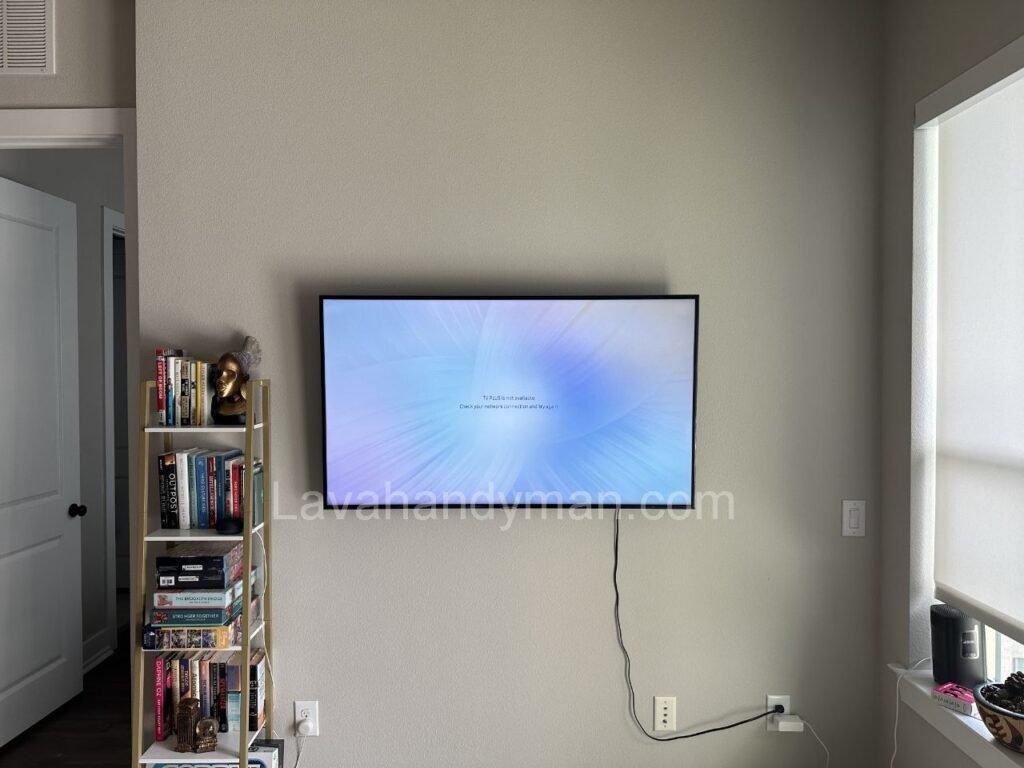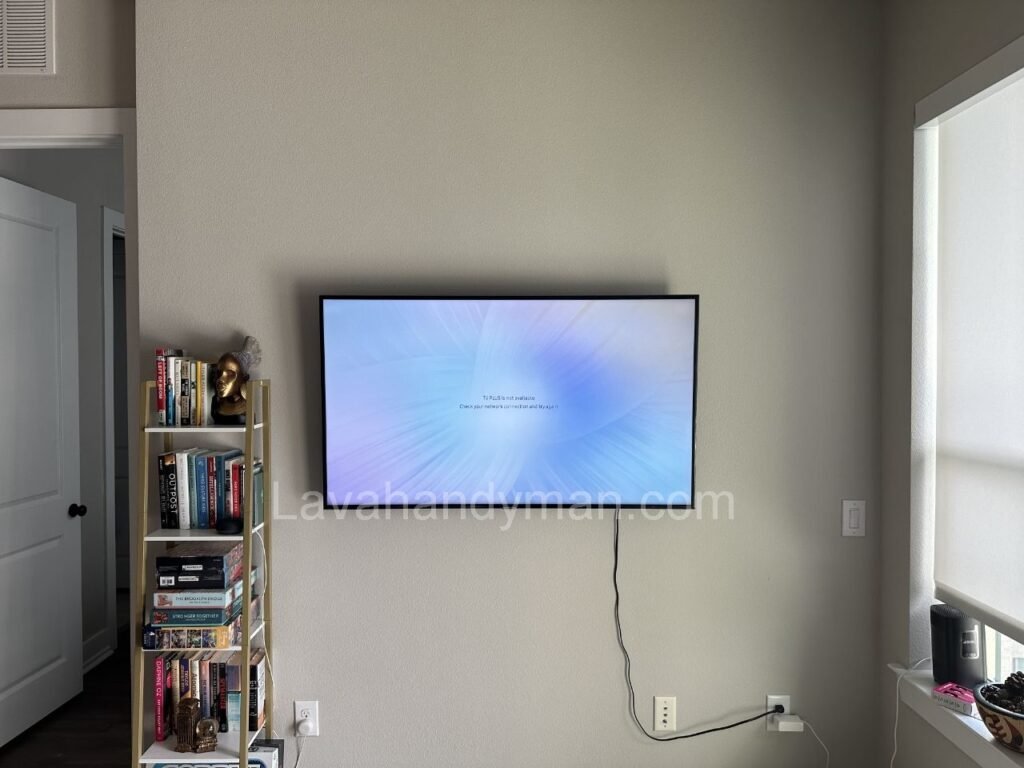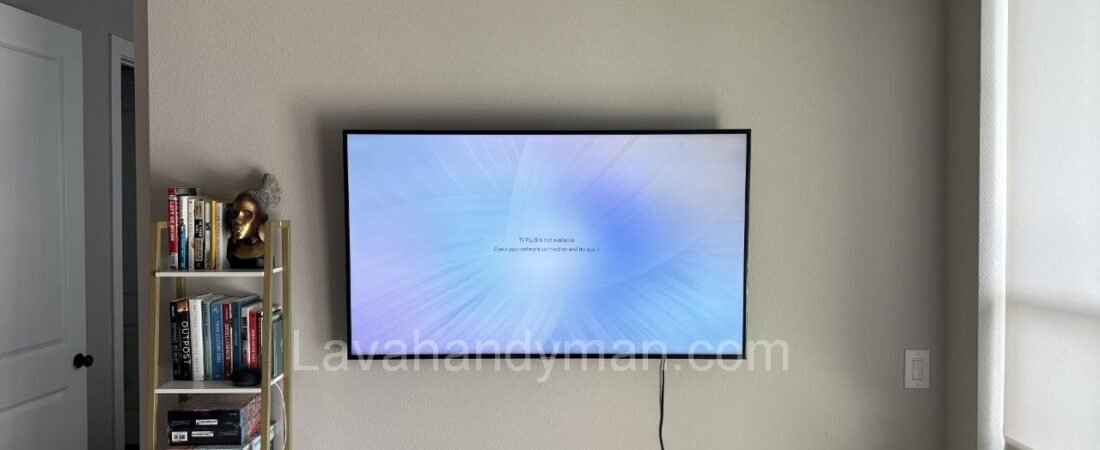Wall-Mounting Your TV at a High Position: Complete Guide
Mounting a TV at a high position is a popular solution in modern interior design. It not only saves space but also keeps the TV safe from damage and adds a sleek, professional look to the environment. However, to ensure a comfortable viewing experience, factors like viewing angle, proper TV bracket, and wall safety must be considered.
🎯 Why Mounting a TV High on the Wall Matters
If a TV is mounted at the wrong height, it may lead to eye strain, neck pain, or even reduced picture quality. That’s why using an adjustable wall mount with tilt functionality is essential when installing the TV higher than eye level.
Wall-Mounting Your TV at a High Position: Complete Guide
✅ Key Considerations for High TV Wall Mounting
1. Proper Viewing Angle
Viewing angle is critical when the TV is mounted high.
🛠 Pro tip: Use Tilting or Full Motion brackets to tilt the screen downward for a more comfortable view.
2. Choosing the Right Bracket
Depending on your space and needs, consider:
- Tilting Bracket: Ideal for above fireplaces or moderately high walls
- Full Motion / Articulating Bracket: Allows full range of motion — swivel, tilt, extend
- Ceiling Mount: Great for commercial spaces or open-plan areas
Wall-Mounting Your TV at a High Position: Complete Guide

3. Correct TV Mounting Height
Ideally, the center of the screen should align with the viewer’s eye level while seated. In high-wall installations, this can be compensated with proper tilting brackets to maintain ergonomic viewing.
4. Safety and Stability
- Use a high-quality, heavy-duty metal bracket
- Ensure the wall is solid (concrete or brick)
- Professional installation is recommended for safety
5. Cable Management
To keep the setup clean and modern:
- Use wall raceways, cable covers, or in-wall installations
- Secure cables behind the TV to keep them out of sight
Wall-Mounting Your TV at a High Position: Complete Guide
⭐ Benefits of High TV Wall Mounting
- Space-saving and clutter-free design
- Improved safety, especially in homes with kids or pets
- Modern, clean aesthetic
- Utilizes unused wall space efficiently
🎯 Standard Viewing Angle for Wall-Mounted TVs | Complete SEO Guide
One of the most important factors to consider when mounting a TV on the wall, especially at a higher elevation, is the optimal viewing angle. This directly affects both visual comfort and picture quality.
Wall-Mounting Your TV at a High Position: Complete Guide
📌 Why is Viewing Angle Important When Mounting a TV?
If the TV is installed at a height that doesn’t align with the viewer’s eye level, it can cause:
- Neck pain and muscle fatigue
- Loss of image quality, especially in older LCD or VA panels
- A poor and uncomfortable viewing experience during movies, sports, or gaming
That’s why it’s essential to respect the correct wall-mount viewing angle for your television.
📐 What Is the Ideal Viewing Angle for a Wall-Mounted TV?
According to professional standards:
- Vertical viewing angle (from eye level to screen center): 0 to 15 degrees downward
- Horizontal viewing angle (left or right from screen center): up to 30–40 degrees
If the TV is installed high on the wall, you should tilt it downward using an adjustable wall mount to maintain this angle.
Wall-Mounting Your TV at a High Position: Complete Guide
🔢 How to Calculate the TV Viewing Angle
Here’s a simple way to estimate the vertical angle:
plaintextCopyEditViewing Angle = arctangent (height difference / viewing distance)
📍 Example:
If the center of the TV is 50 cm (19.6 inches) above eye level, and the viewer sits 2.5 meters (8.2 feet) away:
- Viewing Angle ≈ 11 degrees → Within acceptable range.
Wall-Mounting Your TV at a High Position: Complete Guide
✅ How to Ensure a Proper Viewing Angle When Wall Mounting a TV
- Use a Tilting or Full-Motion Wall Mount
- These mounts allow the screen to tilt downward up to 15–20 degrees.
- Ideal for TVs mounted over fireplaces or in elevated positions.
- Adjust the Viewing Distance
- The farther the viewer is from the screen, the better the angle becomes.
- Suggested distances:
- 55-inch TV → 2.1 meters (6.9 ft)
- 65-inch TV → 2.4–2.7 meters (8–9 ft)
- Choose a TV with a Wide Viewing Angle Panel
- OLED and IPS LCD panels perform better at wide vertical and horizontal angles.
- VA panels often suffer from contrast and color loss when viewed from above.
Wall-Mounting Your TV at a High Position: Complete Guide
⚠️ Common Mistakes When Ignoring Viewing Angles
- Using a fixed bracket for high-mounted TVs
- Not adjusting the tilt angle on elevated installations
- Ignoring the viewer’s distance from the TV
- Choosing a TV panel with poor off-angle performance
Wall-Mounting Your TV at a High Position: Complete Guide
🟢 Summary: Ideal TV Viewing Angle for Wall Mounts
| Factor | Recommended Value |
|---|---|
| Vertical Viewing Angle | 0° to 15° downward |
| Horizontal Viewing Angle | Up to 30–40° from screen center |
| Eye Level Height | 100–110 cm (39–43 inches) from floor |
| Best Wall Mount Type | Tilting or full-motion mount |
| Best Panel Type | OLED or IPS with wide viewing angle |
🔧 How to Choose the Best TV Bracket :
Choosing the right TV bracket plays a crucial role in securely and effectively mounting your TV on the wall. A good bracket not only supports the weight of the TV but also allows you to adjust the viewing angle and improves the overall appearance of the installation.
Wall-Mounting Your TV at a High Position: Complete Guide
Types of TV Brackets and Their Uses
- Fixed Wall Mount
- Simple installation and low cost
- Ideal for TVs mounted at standard eye-level height
- No angle adjustment capability
- Tilting Wall Mount
- Allows tilting the TV up or down
- Perfect for mounting TVs higher on the wall, such as above fireplaces
- Reduces neck strain by optimizing the viewing angle
- Full Motion / Articulating Wall Mount
- Offers rotation, extension, and tilt adjustments
- Best choice for multi-purpose rooms or setups with multiple viewing angles
- Provides maximum flexibility but is usually more expensive
- Ceiling Mount
- Suitable for commercial or specialized spaces
- Suspends the TV from the ceiling with full rotation capability
Wall-Mounting Your TV at a High Position: Complete Guide

Key Factors to Consider When Choosing a TV Bracket
- VESA Compatibility:
Ensure the bracket matches your TV’s VESA mounting pattern for a secure fit. - Weight Capacity:
The bracket should support at least 20% more weight than your TV to guarantee safety. - Adjustability:
Tilting and full-motion brackets are essential for mounting TVs at high positions or where viewing angles vary. - Build Quality and Material:
Choose brackets made from strong metal with standard designs for durability and safety.
Wall-Mounting Your TV at a High Position: Complete Guide
Why Using the Right TV Bracket Matters
Increased TV Lifespan: Minimizes stress on the TV’s stand and panel
Enhanced Safety: Prevents the TV from falling and causing injury or damage
Improved Viewing Comfort: Reduces neck pain and eye strain by enabling proper angle adjustments
Cleaner Appearance: Better cable management and a neat installation look
📏 Optimal Height for Wall-Mounted TV Installation :
Choosing the right height for mounting your TV on the wall is crucial for a comfortable viewing experience and better picture quality. Incorrect height can cause neck and eye strain and reduce viewing comfort.
Wall-Mounting Your TV at a High Position: Complete Guide
Why Is TV Mounting Height Important?
Mounting the TV at the wrong height forces viewers to tilt their neck or eyes excessively up or down, leading to:
- Neck and shoulder fatigue and pain
- Reduced picture quality due to poor viewing angles
- Discomfort during long viewing sessions
Wall-Mounting Your TV at a High Position: Complete Guide
What Is the Standard TV Mounting Height?
The center of the TV screen should be approximately at eye level or slightly lower. This is usually around 100 to 110 cm (39 to 43 inches) from the floor.
Key Tips for Determining the Optimal Height
- Distance from viewer to TV:
The farther the viewing distance, the slightly higher the TV can be mounted, but the center should stay near eye level. - Usage and environment:
In bedrooms or places where viewers watch lying down or reclining, mounting slightly higher is better. - TV size:
Larger TVs benefit from having the center positioned a bit lower to keep the whole screen comfortably in view. - Use of adjustable brackets:
When mounting higher than eye level, always use tilting or full-motion brackets to adjust the viewing angle.
Wall-Mounting Your TV at a High Position: Complete Guide
Simple Formula to Calculate Mounting Height
plaintextCopyEditTV center height = viewer’s eye level + (half of TV height × adjustment factor)
- The adjustment factor typically ranges from 0.85 to 1 depending on the situation.
🔒 Key Tips for Safe and Professional TV Wall Mounting
Mounting your TV on the wall not only enhances the room’s aesthetics and saves space but also requires following safety guidelines and professional techniques to prevent damage to the TV, the wall, and ensure personal safety.
Wall-Mounting Your TV at a High Position: Complete Guide
Why Is Safety Important in TV Installation?
- Prevent TV Falls: Proper mounting prevents the TV from falling, avoiding financial loss or injury.
- Protect the Wall: Avoids cracks or damage to the wall structure.
- Increase TV Longevity: Correct installation extends the life of your TV.
Essential Tips for Professional TV Installation
- Choose the Right and Certified Bracket: Select a bracket that matches your TV’s size and weight, and is made of high-quality materials.
- Check Wall Strength: The wall must be sturdy and stable. Concrete walls or walls with strong wooden studs are ideal. Avoid mounting on weak or thin walls.
- Use Suitable Screws and Anchors: Screws and anchors should be appropriate for the wall type and TV weight, and must be installed correctly.
- Level the TV Precisely: The TV must be mounted perfectly level to evenly distribute the load.
- Manage Cables Properly: Arrange cables neatly without tension to prevent damage to ports and cables.
- Hire a Professional Installer When Needed: For large TVs or sensitive walls, professional installation is recommended.
Wall-Mounting Your TV at a High Position: Complete Guide
Essential Tools and Equipment for Professional Installation
Safety equipment such as gloves and protective glasses
Certified and compatible TV bracket
High-quality screws and wall anchors matching the wall type
Level tool for precise alignment
Drill with suitable drill bits
Screwdrivers and wrenches
🎛️ Cable Management for Wall-Mounted TVs | Practical and Professional Guide
Proper cable management during TV wall mounting is essential for enhancing aesthetics, safety, and equipment performance.
Wall-Mounting Your TV at a High Position: Complete Guide
Importance of Cable Management
- Prevent tangling and damage: Organized cables help avoid disconnections, damage, and signal degradation.
- Improve appearance: Hidden and neat cables create a professional and clean look.
- Increase safety: Prevent cables from falling, getting caught, or being pulled, which can cause TV falls or equipment damage.
- Ease maintenance and repairs: Organized cables allow quicker and easier access to devices.
Effective Cable Management Methods
- Use cable raceways: Plastic or metal channels that organize and hide cables.
- Cable ties and wraps: Useful for bundling and tidying cables neatly.
- In-wall cable management: Concealing cables inside walls for a completely clean look (requires expertise).
- Use appropriately sized cables: Avoid excess length to prevent tangling.
- Label cables: Helps with easy identification during maintenance and repairs.
Wall-Mounting Your TV at a High Position: Complete Guide
Safety Tips for Cable Management
- Avoid excessive pulling or stretching of cables.
- Keep cables away from high-traffic areas.
- Use high-quality, certified cables for better safety and performance.
Wall-Mounting Your TV at a High Position: Complete Guide
Conclusion
Proper cable management is key to a beautiful, safe, and efficient wall-mounted TV setup. Following these methods and safety tips ensures a neat and professional space.
✅ Summary Table of Key Installation Points
| Factor | Importance | Recommended Action |
|---|---|---|
| Viewing Angle | 🔥 Critical | Use tilt brackets to aim screen downward |
| Bracket Type | 🔧 Essential | Full motion mount for flexibility |
| Mounting Height | 📐 Comfort-Focused | Install around 100–110 cm or adjust with tilt |
| Wall Strength | ⚠️ Safety | Prefer concrete/brick; reinforce drywall if used |
| Cable Management | 🎯 Aesthetic & Safety | Use raceways or in-wall routing |
Wall-Mounting Your TV at a High Position: Complete Guide
📝 Final Thoughts
Mounting your TV high on the wall can greatly enhance both aesthetics and functionality, but it must be done correctly. Choose the right bracket, optimize the viewing angle, ensure proper installation, and manage cables neatly for the best results.
At LavaHandyman.com, we don’t just help you understand TV tech — we also offer expert TV installation services, making sure your home entertainment setup looks and performs at its best.
📞 Need Help?
Let us take care of the hard work while you sit back and relax.
📍 Serving: Austin, Round Rock, Cedar Park & more
📱 Call or Text: (737) 420-6992
🌐 Visit: https://lavahandyman.com


